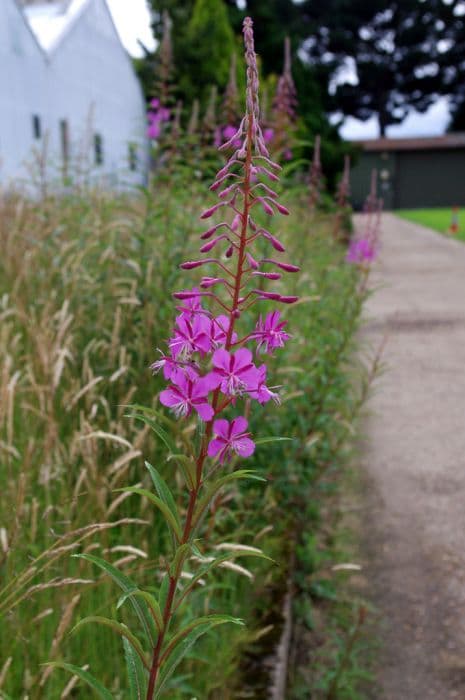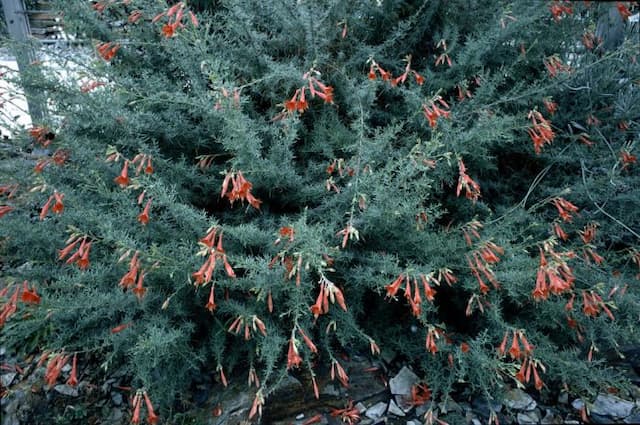Evening primrose Oenothera glazioviana

ABOUT
The plant commonly known as the Evening Primrose displays a distinct appearance characterized by its bright yellow flowers. Each flower typically has four broad petals that open in the evening and close by the following noon on sunny days. The petals merge at the base, forming a tube-like structure that attaches to the plant. These yellow blooms grow in clusters at the tip of the plant's stem and branches, giving it a particularly striking look when many are in bloom simultaneously. Below the flowers, you will find narrow, lance-shaped leaves that are arranged in a rosette at the base of the stem and alternately along the stem itself. The leaves have a slightly toothed margin, adding texture to the plant's overall appearance. The Evening Primrose’s stems are usually reddish and covered with fine hairs. The plant's fruit is a capsule with multiple chambers that split open at maturity to release the seeds. Overall, the Evening Primrose has a somewhat robust and bushy appearance, with a concentration of bright yellow flowers that act as a beacon for pollinators in its environment.
About this plant
 Names
NamesFamily
Onagraceae
Synonyms
Large-Flowered Evening Primrose, Redsepal Evening Primrose, Giant Evening Primrose
Common names
Oenothera erythrosepala, Oenothera lamarckiana.
 Toxicity
ToxicityTo humans
Oenothera glazioviana, commonly known as Giant evening primrose, is not widely regarded as a poisonous plant to humans. There is little evidence to suggest that consumption of parts of this plant would lead to serious illness or severe symptoms of poisoning. However, as with any plant not typically recognized for its edibility, individual sensitivity or allergic reactions can possibly occur if ingested. These could include mild gastrointestinal upset such as nausea, vomiting, or diarrhea. If such symptoms do occur after ingestion, medical advice should be sought.
To pets
Giant evening primrose, or Oenothera glazioviana, is not generally considered toxic to pets. There is limited information available on any significant toxic effects of this plant on animals. Nonetheless, ingestion of plant material by pets, particularly in large quantities, could potentially lead to gastrointestinal discomfort, including symptoms such as vomiting and diarrhea. If a pet appears unwell after consuming this plant, it is advisable to consult with a veterinarian.
 Characteristics
CharacteristicsLife cycle
Biennials
Foliage type
Deciduous
Color of leaves
Green
Flower color
Yellow
Height
3-5 feet (0.91-1.52 meters)
Spread
1-2 feet (0.30-0.61 meters)
Plant type
Herb
Hardiness zones
5
Native area
South America
Benefits
 General Benefits
General Benefits- Ecological Attractor: Large, bright flowers of Oenothera glazioviana, commonly known as Evening Primrose, attract pollinators such as bees and moths, benefiting the local ecosystem.
- Ornamental Value: With its striking yellow flowers, Evening Primrose adds aesthetic appeal to gardens and landscapes.
- Wildlife Habitat: It provides shelter and breeding spots for insects, thus supporting biodiversity.
- Soil Stabilization: Its root system can help prevent soil erosion, particularly on slopes and banks.
- Nectar Source: Evening Primrose is a rich source of nectar, providing food for nocturnal pollinators such as moths.
- Drought Resistance: Once established, this plant is tolerant of drought, rendering it suitable for xeriscaping in dry climate zones.
- Low Maintenance: Requires minimal upkeep compared to other garden plants, making it a convenient choice for gardeners.
- Edible Parts: The roots and young shoots are edible, and can provide a food source for both humans and wildlife.
 Medical Properties
Medical PropertiesThis plant is not used for medical purposes.
 Air-purifying Qualities
Air-purifying QualitiesThis plant is not specifically known for air purifying qualities.
 Other Uses
Other Uses- Photography: Evening primrose oil can be used in alternative photography processes, where it acts as an organic binder or emulsion in certain historic photographic printmaking techniques.
- Erosion Control: The plant’s ability to grow in poor soil and stabilize banks makes it useful for erosion control in some landscapes.
- Dye Production: Evening primrose petals can be used to create a yellow or green dye for fabrics, though this is not a common use.
- Education and Research: Oenothera glazioviana is often used in botanical and ecological studies due to its interesting genetics and adaptive traits.
- Fishing Bait: The leaves and stems of evening primrose may sometimes be used as bait in fishing due to their attractive scent and texture to certain fish.
- Garden Design: With its bright yellow flowers, it can be selectively planted to create patterns or swathes of color in landscape designing.
- Companion Planting: Some gardeners use evening primrose as a companion plant, as it is believed to attract beneficial insects like bees and butterflies to the garden.
- Natural Barriers: Its bushy growth habit allows evening primrose to be used as informal hedges or living fences in natural garden settings.
- Wildlife Habitat: Evening primrose provides nectar for pollinators as well as habitat for insects, which are important food sources for birds and other wildlife.
- Light Source: Historically, the stems of evening primrose, when dried and dipped in fat, could serve as a rudimentary lamp wick to provide light.
Interesting Facts
 Feng Shui
Feng ShuiThe Evening Primrose is not used in Feng Shui practice.
 Zodiac Sign Compitability
Zodiac Sign CompitabilityThe Evening Primrose is not used in astrology practice.
 Plant Symbolism
Plant Symbolism- Healing: Oenothera glazioviana, commonly known as the Evening Primrose, is often associated with medicinal properties and healing, as many parts of the plant have historically been used for therapeutic purposes.
- Resilience and Adaptability: The Evening Primrose is known for its ability to adapt to challenging environments and soil conditions, symbolizing resilience in the face of adversity.
- Beauty and Radiance: As a plant that opens its flowers at dusk, the Evening Primrose represents beauty and radiance in low light, reminding us that beauty can thrive even in the darkness.
- Patience and Anticipation: The blooming of its flowers in the evening suggests patience and the anticipation of the closing day or the onset of night, symbolizing the idea that everything has an optimal time.
 Water
WaterEvening primrose prefers consistent moisture but is quite drought tolerant once established. Watering should be done deeply once a week, providing about one to one and a half gallons per square yard, depending on the soil type and climate conditions. During hot, dry spells, increase watering to twice per week. Ensure the soil is well-draining to prevent root rot. Reduce watering in the autumn as the plant prepares for dormancy.
 Light
LightEvening primrose thrives in full sun, requiring at least six hours of direct sunlight per day. The best spot for the plant is in an area where it can receive unfiltered sunlight during the majority of the day. Partial shade is tolerated but may result in fewer blooms.
 Temperature
TemperatureEvening primrose enjoys a temperate climate and can survive in temperatures as low as 20°F and as high as 90°F. However, the ideal temperature range for the plant is between 60°F and 70°F. It is important to protect the plant from frost, which can damage the foliage and blooms.
 Pruning
PruningEvening primrose should be pruned to remove spent blooms and encourage further flowering. The best time for pruning is after the plant has finished blooming, typically in late summer or early fall. Cut back the stems by about one third to maintain shape and promote healthy growth for the next season.
 Cleaning
CleaningAs needed
 Soil
SoilEvening Primrose requires well-draining soil with a pH of 5.5 to 7. The best mix is loam-based with added compost and coarse sand to improve drainage.
 Repotting
RepottingEvening Primrose does not commonly require repotting as it is often treated as a biennial, but if necessary, repot every 2-3 years in spring.
 Humidity & Misting
Humidity & MistingEvening Primrose prefers moderate humidity levels but is quite adaptable and can tolerate the humidity levels typically found in most outdoor environments.
 Suitable locations
Suitable locationsIndoor
Ensure full sun, good air circulation, and well-draining soil.
Outdoor
Plant in full sun with well-drained soil, water occasionally.
Hardiness zone
5-9 USDA.
 Life cycle
Life cycleOenothera glazioviana, commonly known as 'Large-flowered Evening Primrose', begins its life cycle as a seed, which typically germinates in the spring when conditions are favorable, with warmth and moisture. The seedling emerges and develops into a rosette of leaves close to the ground. After the vegetative stage, during which the plant grows and accumulates resources, it enters a period of bolting, where a floral stalk elongates rapidly during the summer. Once the plant reaches maturity, it produces large, showy yellow flowers that open in the evenings from early summer to early autumn and are pollinated by nocturnal insects such as moths. Following pollination, the flowers develop into elongate capsules containing numerous tiny seeds. The plant completes its life cycle with the seeds dispersing into the environment, ready to germinate and start the cycle anew, usually dying after one or two years, classifying it as a biennial.
 Propogation
PropogationPropogation time
Spring to Summer
The Evening Primrose (Oenothera glazioviana) is commonly propagated by seed. The best time for sowing is either in the fall to allow a natural stratification period over the winter which enhances germination, or in the spring after a period of cold stratification. To propagate by seed, one should scatter the seeds on the surface of a well-draining soil mix and lightly press them into the soil. These seeds generally need light to germinate, so they should not be covered. The seedlings will emerge in about 2 to 3 weeks at room temperature if planted in the spring. Thinning may be necessary to ensure the healthiest plants have room to grow. Once the seedlings are large enough to handle, typically when they have developed a couple of true leaves, they should be transplanted into individual pots or directly into the garden.









